Customer Experience (CX): Strategy, Metrics, and Business Impact

What is customer experience?
Customer experience (CX) is the overall impression people form of your brand based on every interaction they have with it—before, during, and after a purchase. It encompasses every touchpoint in the buyer’s journey: marketing ads that spark interest, website usability, product performance, checkout processes, customer support conversations, and even post-purchase follow-ups. CX shapes how customers feel about your brand and has a direct impact on loyalty, word-of-mouth referrals, and revenue.
Customer service vs. customer experience
- Customer service is a specific function: helping customers solve problems, answering questions, and guiding product use.
- Customer experience is the umbrella term: it includes customer service but also every other brand interaction—marketing messages, website navigation, delivery, billing, etc.
Example: A shopper might enjoy a smooth checkout on your e-commerce site (CX), yet still need to call support if the package arrives damaged (CS). Both matter, but CX is the big picture.
Why CX matters: Seven key benefits
Builds a stellar reputation
-
- Word-of-mouth power: After a great experience, 77% of customers will recommend your brand to friends.
- Trust transfers: 90% trust peer recommendations over ads.
- Case in point: When the Carolina Panthers revamped their online shop for mobile ease, word-of-mouth led to an 83% jump in mobile conversions.
Boosts customer retention
-
- Cost efficiency: Acquiring new customers costs up to five times more than retaining existing ones.
- Higher success rates: Selling to current customers has a conversion rate of 60–70%, versus 5–20% for prospects.
- Real-world example: JPMorgan Chase’s “Everyday Express” branches blend digital services with in-person advice, keeping digital-savvy clients engaged and reducing churn.
Drives revenue growth
-
- Faster growth: Companies with top-tier CX grow revenues five times faster than competitors with poor CX.
- Sales uplift: Better support leads directly to more sales.
- AO.com story: By streamlining jargon, adding 360° visuals, and curating collections for TVs, AO.com lifted average order values £50 above the market average.
Increases customer lifetime value (CLV)
-
- Higher spend, more trips: Engaged customers buy 90% more often, spend 60% more per purchase, and have triple the annual value.
- Power of consistency: Shoppers with positive past experiences spend 140% more over time.
- Amazon’s one-day delivery: A viral tweet about Amazon’s lightning-fast German shipping, personally signed by an employee, showed how small gestures fuel repeat purchases.
Creates a competitive advantage
-
- Switching costs: 57% of customers jump to competitors seeking better experiences.
- Brand differentiation: Exceptional CX sets you apart in crowded markets.
- Sainsbury’s “giraffe bread”: A three-and-a-half-year-old’s letter led Sainsbury’s to rebrand “tiger bread” as “giraffe bread,” delighting customers and earning earned media buzz.
Boosts brand awareness and trust
-
- Social proof: 85% of consumers trust online reviews as much as personal recommendations; people read up to 10 reviews before buying.
- Visual signals: Brand logos, five-star ratings, and review counts build recognition and confidence at first glance.
Reduces marketing and service costs
-
- Streamlined operations: Efficient journeys cut wasted handoffs, duplicate steps, and repeated explanations.
- ROI on CX: Improving CX from average to “wow” delivers 30–50% more value in retention and renewals, while reducing support costs by 15–20%.
Measuring customer experience
To optimize CX, you need clear, actionable metrics. A reliable customer experience management software helps consolidate these insights across touchpoints.
Customer Satisfaction (CSAT) surveys
-
- Deployed after key interactions (e.g., purchase, support call) to gauge immediate sentiment.
- Track trends over time and correlate with feature releases or process changes.
Net Promoter Score (NPS)
-
- Asks: “How likely are you to recommend us?” on a 0–10 scale.
- Segment NPS by touchpoint—product use, support, sales—to pinpoint strengths and gaps.
Churn analysis
-
- Monitor customer departure rates and dive into exit surveys or support logs.
- Identify common factors driving cancellations, then address root causes.
Support ticket trends
-
- Review volume and repeat issues in the helpdesk data.
- Resolve systemic problems to reduce ticket counts and improve satisfaction.
Feature and product requests
-
- Offer forums or feedback channels for customers to suggest improvements.
- Prioritize recurring asks to show you’re listening and drive engagement.
Quick Pro-Tip:
CCaaS solutions simplify the collection of CX metrics by integrating with CRM, analytics, and communication tools, giving businesses real-time visibility into performance across multiple customer channels.
Crafting your CX strategy
Map the customer journey.
-
- Identify every touchpoint from awareness to advocacy.
- Note pain points and opportunities for delight.
Set measurable goals
-
- Example: Increase NPS by 10 points in six months; reduce average support response time to under two hours.
Align cross-functional teams
-
- Marketing, Product, Sales, and Support must share CX metrics and insights.
- Break down silos—ensure everyone owns the customer’s success.
Invest in tools and training
-
- Leverage CRM platforms, live chat, AI chatbots, and analytics dashboards.
- Empower employees with soft-skills training and decision-making authority.
Continuously iterate
-
- Treat CX as an ongoing practice, not a one-time project.
- Regularly collect feedback, test improvements, and adapt to evolving expectations.
Conclusion
Customer experience is far more than good customer service—it’s the sum total of every interaction a person has with your brand. By focusing on both exceptional products and empowering your people, you can build lasting loyalty, generate word-of-mouth, and drive profitable growth. Measuring CX through CSAT, NPS, churn rates, and support trends reveals clear paths for improvement. Ultimately, a relentless commitment to CX excellence separates market leaders from the competition—and keeps customers coming back, again and again.
The post Customer Experience (CX): Strategy, Metrics, and Business Impact appeared first on EU Business News.












































